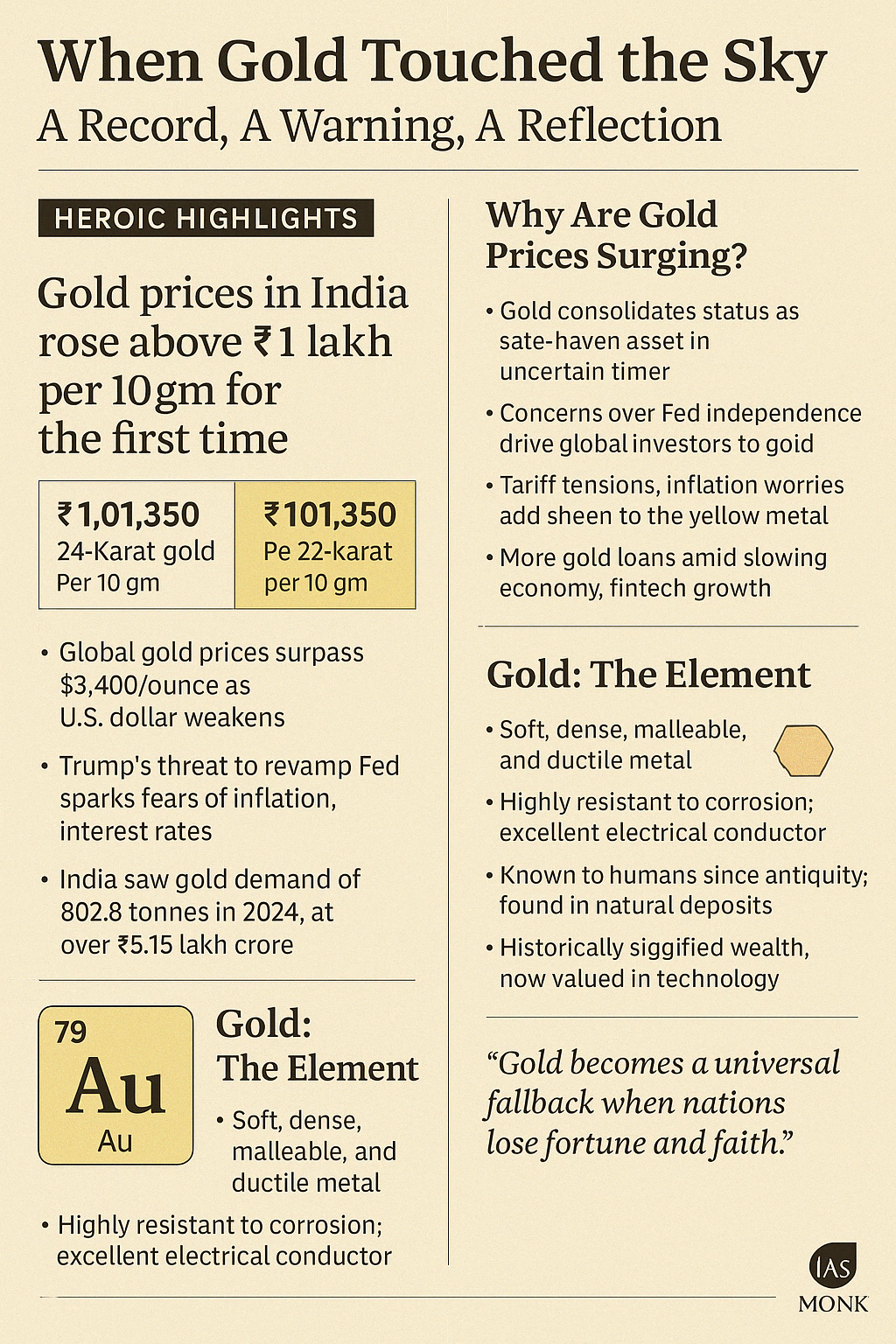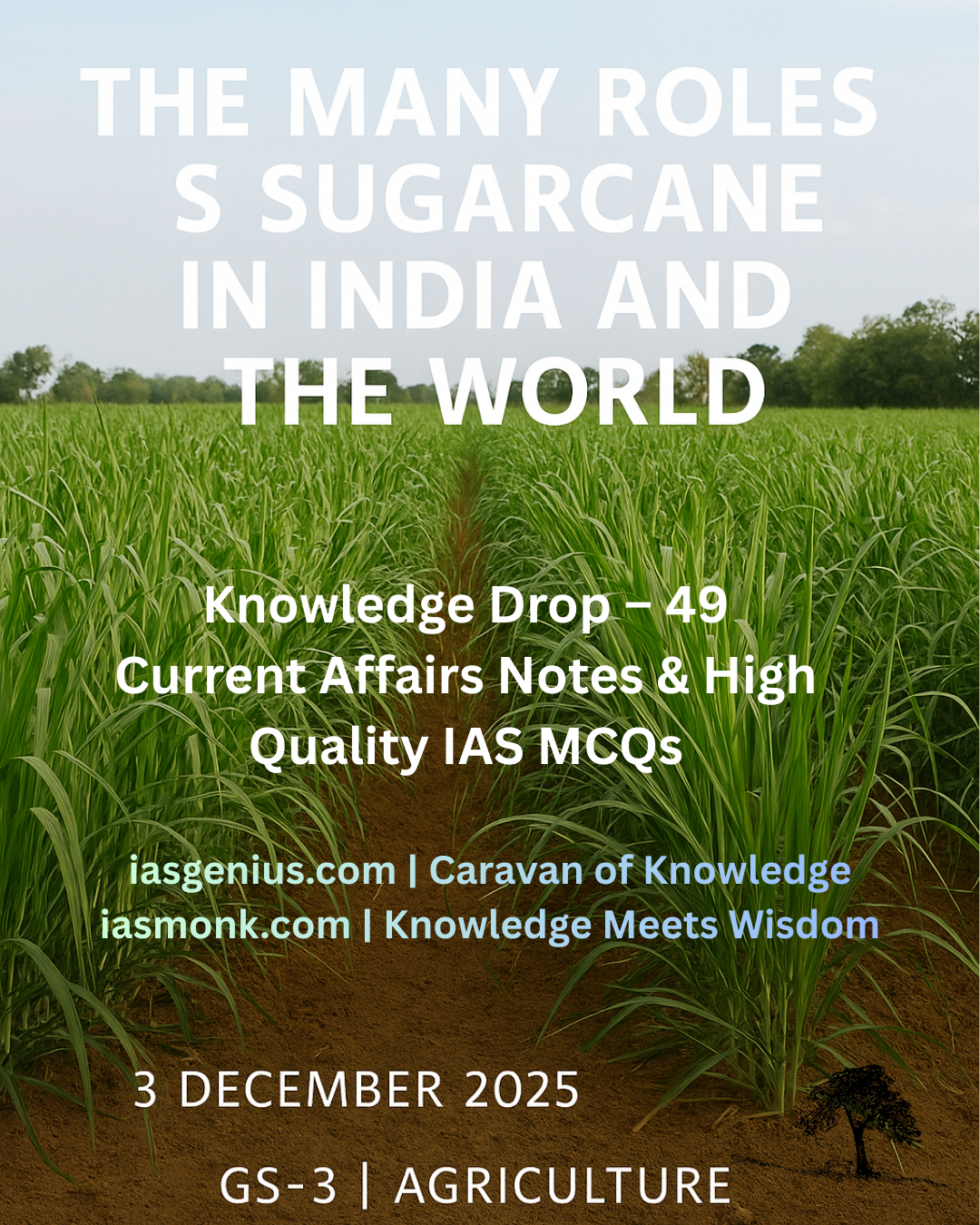
004-Apr 22, 2025: 🪙 When Gold Touched the Sky: A Record, A Warning, A Reflection
📅 April 22, 2025
📌 Highlight: Relevant Essay Attached

Thematic Focus
📈 Indian Economy & Global Markets | 🧪 Science of Elements | ⚖️ Geopolitical Economics
Intro
On April 22, 2025, the price of gold in India crossed the ₹1 lakh mark per 10 grams—a threshold both symbolic and staggering. While jewellers rejoiced and gold loan companies scrambled, economists stared at the charts in silence. Behind this glitter lies a story not just of inflation or tariffs, but of trust, fear, and elemental permanence. A yellow metal turned mirror—reflecting a world in flux.
Heroic Highlights
- 24-karat gold touched ₹1,01,350 per 10 gm in Mumbai bullion markets; 22-karat stood at ₹92,900.
- Global prices surged past $3,400/ounce, with New York recording $3,486.85.
- The surge was driven by:
- US dollar hitting a three-year low.
- US President Donald Trump’s threat to overhaul the Federal Reserve.
- Fears of inflation, interest rate volatility, and Fed’s diminishing independence.
- Central bank buying—especially from China—boosted global demand.
- India, the second-largest gold market, saw demand of 802.8 tonnes in 2024, worth over ₹5.15 lakh crore.
- Spike in gold loans, with more households pledging gold due to economic slowdown.
Concept Explainer
1. Why Is Gold Rising Now?
Gold is a “safe haven” during uncertainty. With the US dollar weakening due to Fed-Trump tension, and geopolitical strains rising, gold becomes the universal fallback. It also protects against inflation, which now looms large due to tariffs and supply disruptions.
2. India’s Golden Heart
Gold is deeply embedded in Indian culture—not just as jewellery, but as emotional and financial security. In times of crisis, families turn to gold loans, supported by fintech platforms that bring accessibility even to remote villages.
3. Gold as an Element – A Scientific Marvel
- Symbol: Au (from Latin Aurum)
- Atomic Number: 79
- Properties: Highly malleable, ductile, resists corrosion, conducts electricity.
- History: Known to humans since 3000 BCE; used in temples, currency, and now quantum tech.
- It never rusts, never fades, and never bows. That’s why gold doesn’t just glitter—it endures.
GS Paper Mapping
- GS Paper 3: Indian Economy – Inflation, financial markets, international trade
- GS Paper 1 (Culture): Socio-economic role of gold in Indian society
- GS Paper 3 (Science & Tech): Periodic table, properties of metals, applications in tech
- Essay Paper: The allure of gold: Economy, culture, and chemistry in one element
A Thought Spark — by IAS Monk
“When the world grows uncertain, it listens not to kings, but to elements.”
Gold is more than value. It is memory.
It is the last promise we carry when all others break.
Essay:
🪙 When Gold Touched the Sky — A Record, A Warning, A Reflection
“Gold becomes a universal fallback when nations lose fortune and faith.”
Introduction
On April 22, 2025, the Indian bullion market witnessed a historic moment. The price of gold breached the ₹1 lakh mark per 10 grams for the first time ever. More than a market event, it was a symbolic threshold—signaling growing global anxiety, geopolitical unrest, and shaken investor faith in fiat systems.
While weddings and traditions continued to demand the yellow metal, economists and strategists saw in its surge a deeper message: gold is no longer just a commodity, but a barometer of the world’s trust.
The Spark Behind the Surge
The current rally in gold prices has multiple drivers. The foremost is the weakening of the US dollar, driven by tensions between President Donald Trump and the Federal Reserve. Trump’s recent comments about removing Jerome Powell, and calls for deeper interest rate cuts, have fueled investor uncertainty about the Fed’s independence.
The resulting erosion in confidence has led investors to flee dollar-based assets, turning to the one element that resists political tremors—gold. The US Dollar Index plummeted to a three-year low, triggering a spike in gold prices globally. In New York, gold soared above $3,480/ounce. In India, it crossed ₹1,01,350 per 10 grams.
The India Factor: A Cultural and Economic Bond
India is the second largest consumer of gold in the world after China. In 2024, Indian demand stood at over 802.8 tonnes, valued at ₹5.15 lakh crore. But India’s connection to gold goes beyond economics—it is deeply cultural.
Gold in Indian households is wealth, tradition, insurance, and legacy. During financial need, families often pledge gold for loans—especially in rural and semi-urban areas. Fintech platforms have further made gold loans accessible and efficient.
In recent months, the economic slowdown has pushed more people toward pledging their jewellery, as a trusted route to financial support.
The Global Forces at Play
Beyond India, the global surge in gold is being powered by:
– Central bank buying from countries like China and Russia.
– Concerns over persistent inflation and fragile global supply chains.
– Continued geopolitical risk, including the Russia-Ukraine war.
In such times, gold serves as a universal store of value. It isn’t just shiny—it’s stable. And in a world where economic alliances are shifting and political institutions are under strain, stability is everything.
Gold — The Elemental Constant
Gold is more than tradition—it is chemistry. With an atomic number of 79 and symbol Au (from Latin ‘Aurum’), gold is one of the most stable elements on the periodic table.
It is:
– Soft, ductile, and malleable.
– Highly resistant to corrosion.
– An excellent conductor of electricity.
Its use extends from temples and jewellery to satellites, quantum computing, and bioengineering. Gold never rusts. It never fades. And it never loses value in a crisis—making it not just a luxury, but a legacy.
Conclusion
Gold’s rise is not just about prices—it’s about perception. It reflects what investors fear and where they place their faith. As inflation rises, central banks wobble, and global conflicts intensify, gold silently rises—unmoved and undefeated.
The crossing of ₹1 lakh per 10 gm is a financial headline. But it is also a philosophical marker: that when systems tremble, societies still trust an ancient element of sunlight and silence.
We may wear it, worship it, or sell it. But gold, as always, simply waits.
“In every age of uncertainty, gold remains humanity’s quietest anchor.”
📘 Download this Essay as a PDF
(Currently free — soon a nominal ₹5 download fee will apply)


















